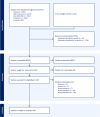Exploring evidence of healthcare-seeking pathways for maternal complications in Sub-Saharan Africa: a scoping review
- PMID: 40448106
- PMCID: PMC12124026
- DOI: 10.1186/s12884-025-07745-3
Exploring evidence of healthcare-seeking pathways for maternal complications in Sub-Saharan Africa: a scoping review
Abstract
Background: Maternal mortality in Sub-Saharan Africa (SSA) accounted for 70% of global maternal deaths in 2020. Delay/failure in care-seeking is linked with a high proportion of maternal deaths. However, evidence is limited on how women and families recognise complications and decide to seek care for complications. In this scoping review, we examined evidence of the recognition of maternal complications, decision-making, and care-seeking during maternal complications from women, families, and community perspectives in SSA.
Methods: A scoping review was conducted following Joanna Briggs Institute guidelines. We report findings using Preferred Reporting Items for Systematic Review and Meta-Analysis scoping review extension checklist. We searched five electronic databases (Medline, Scopus, Web of Science, ProQuest, Emcare) and Google Scholar and included studies published in English between 2016 and 2024. A qualitative content analysis was undertaken.
Results: Of 16,777 articles identified, 46 were included (29 qualitative, 11 quantitative, and six mixed methods). About half the studies (52%) were from eastern SSA, and 30.4% were from western SSA. Few studies (10.9%) were from Southern SSA, and just one was from central SSA. Seventeen studies discussed at least some form of care-seeking pathway. Frequently, women did not recognise the symptoms and severity of complications, and others (mothers-in-law/mother, partners, and traditional birth attendants (TBA)) were involved. TBAs were widely involved in illness recognition but failed to recognise the severity of complications. Partners were the primary decision-makers in seeking care, and TBA and mothers-in-law were also frequently involved, while women were less involved. Most women initially sought care from informal sources of care and visited health facilities after using informal sources. Financial issues, transportation, distance, perceived causes of supernatural, fear of caesarean section, cultural norms, and trust in TBA care were barriers, while knowledge of complications, women's decision-making, social support, lived experience/witnessing others, antenatal care, and user-free health services were enablers to seek care from health facilities.
Conclusions: This study highlights the complex care-seeking pathway during maternal complications and the need for further research focusing explicitly on each care-seeking process. Efforts to reduce identified barriers and maximise enablers may improve timely and appropriate care-seeking.
Keywords: Care-seeking; Decision-making; Illness recognition; Obstetric complication; Pregnancy complication.
© 2025. The Author(s).
Conflict of interest statement
Declarations. Ethical approval: Not applicable. Consent for publication: Not applicable. Competing interests: The authors declare no competing interests.
Figures



Similar articles
-
Illness recognition, decision-making, and care-seeking for maternal and newborn complications: a qualitative study in Sarlahi District, Nepal.J Health Popul Nutr. 2017 Dec 21;36(Suppl 1):45. doi: 10.1186/s41043-017-0123-z. J Health Popul Nutr. 2017. PMID: 29297386 Free PMC article.
-
Illness recognition, decision-making, and care-seeking for maternal and newborn complications: a qualitative study in Jigawa State, Northern Nigeria.J Health Popul Nutr. 2017 Dec 21;36(Suppl 1):46. doi: 10.1186/s41043-017-0124-y. J Health Popul Nutr. 2017. PMID: 29297412 Free PMC article.
-
Appropriateness and timeliness of care-seeking for complications of pregnancy and childbirth in rural Ethiopia: a case study of the Maternal and Newborn Health in Ethiopia Partnership.J Health Popul Nutr. 2017 Dec 21;36(Suppl 1):50. doi: 10.1186/s41043-017-0120-2. J Health Popul Nutr. 2017. PMID: 29297394 Free PMC article.
-
Men's involvement in maternal health in sub-Saharan Africa: A scoping review of enablers and barriers.Midwifery. 2024 Jun;133:103993. doi: 10.1016/j.midw.2024.103993. Epub 2024 Apr 7. Midwifery. 2024. PMID: 38626505
-
Maternal perceptions of the quality of Care in the Free Maternal Care Policy in sub-Sahara Africa: a systematic scoping review.BMC Health Serv Res. 2020 Oct 1;20(1):911. doi: 10.1186/s12913-020-05755-9. BMC Health Serv Res. 2020. PMID: 33004029 Free PMC article.
References
-
- Aliyu LD, Kadas AS, Mohammed A, Abdulllahi HM, Farouk Z, Usman F, et al. Impediments to maternal mortality reduction in Africa: a systemic and socioeconomic overview. J Perinat Med. 2023;51(2):202–7. - PubMed
-
- World Health Organization. Trends in Maternal Mortality 2000 to 2020: Estimates by WHO, UNICEF, UNFPA, World Bank Group and UNDESA/Population Division. 2023.
-
- United Nation Development Programme. Sustainable Development Goals: 2030- Agenda. 2015.
-
- Say L, Souza JP, Pattinson RC. Maternal near miss–towards a standard tool for monitoring quality of maternal health care. Best Pract Res Clin Obstet Gynaecol. 2009;23(3):287–96. - PubMed
Publication types
MeSH terms
LinkOut - more resources
Full Text Sources
Medical
Research Materials

